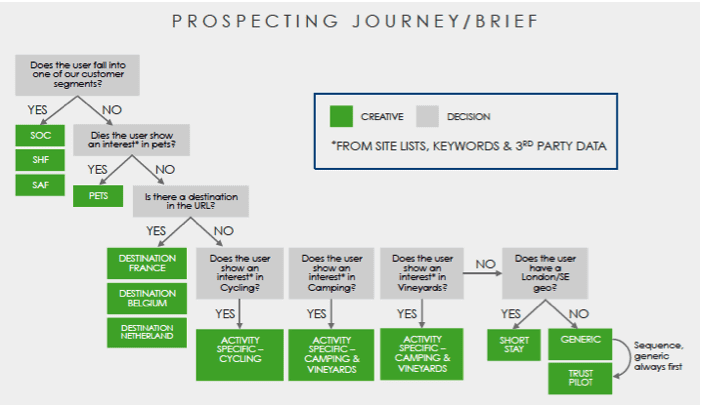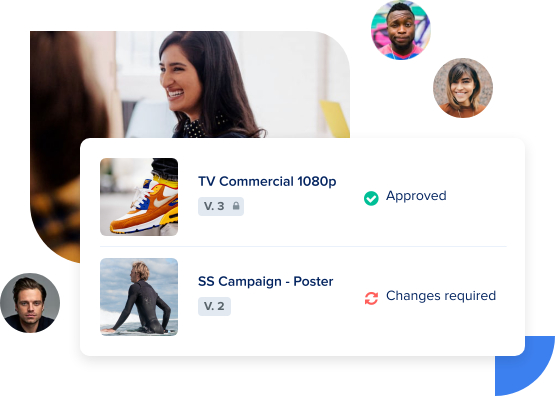In the age of personalization, it's crucial for marketers to deliver relevant and engaging content to each individual user or account. This is where Dynamic Creative Optimization (DCO) comes in, offering a powerful solution to tailor your ads for a truly customized experience.
We're going to dive deep into the world of DCO, exploring its mechanics, benefits, and the essential tools that can help you unlock its full potential. You'll gain a solid understanding of how DCO works, its role in the ever-changing digital landscape, and the best practices to ensure your campaigns resonate with your target audience.
DCO is a type of display ad technology that automatically builds real-time campaigns tailored to the individual, using a combination of historical insights and data at the moment of serving the ad.
DCO tends to outperform more static digital ad types for a couple of key reasons. For one, because DCO pulls real-time, context-specific data to determine what to display, consumers are more likely to see ads they consider "relevant, " which by extension, means they'll be more likely to click and convert.
Second, dynamic ads are tested and optimized through automated multivariate testing, segment specific historical data, and other targeting variables.
Here, the platform's built-in AI handles the entire testing process--allowing the platform to predict which elements will perform best based on data, rather than relying on human intuition.
In this guide, we’ll look at how dynamic creative optimization works, why more marketing departments are investing in DCO campaigns, and how you can set one up for yourself.
What we'll cover
Table of contents
How does Dynamic Creative Optimization (DCO) Work?
Dynamic Creative Optimization uses machine learning technology to serve up personalized ad content based on real-time data.
DCO ad servers typically receive inputs from two main sources: your data management platform (DMP), which handles the data feeds, and your creative management platform (CMP), which manages creative elements like ad copy and visual assets.
DCO ads pull data from a variety of sources, including browsing history, shopping habits, device, weather, location, IP address, CRM records, and more--which are managed through a centralized DMP.
The DMP integrates with the DCO ad server, feeding it real-time data from all of your connected sources, allowing the server to generate ads based on the information it receives automatically.
The DCO ad platform also integrates with your CMP, allowing it to pull various graphical elements and copy into the server to assemble the ad.
The optimization process breaks into two main steps:
First, the engine chooses which elements to include in the ad--that might mean determining how many products to display in a retargeting ad or whether to use video or a still image. DCO platforms can now do this in real-time, using geolocation data or specific behaviors to determine which creative elements are most relevant for an individual shopper.
From there, the engine determines the best way to arrange these ad components to create the right look and feel for each visitor.
At this stage, the DCO platform applies machine learning to optimize things like color scheme, copy, the size of each ad element, and so on most likely to lead to a conversion.
Two levels of DCO
There are two levels of DCO: dynamic and static. Here’s a quick look at what each of these entails:
Dynamic
Dynamic DCO refers to pre-made ad variants that feature specific data-based elements which are selected and controlled by an algorithm. This type of DCO is easy to set up, doesn’t require any advanced coding, and allows marketers to serve up optimized, engaging ads featuring rich media.
Static
Static DCO refers to the static ad units that use an algorithm to “decide” which creatives are shown to the end-user. Unlike dynamic DCO, this type of DCO uses static templates--which puts a cap on the number of ad variations you can serve users. Additionally, static DCO can be difficult to set up, as it requires complex coding and preparation.
How is DCO different from dynamic creative?
Dynamic Creative describes the process of dynamically assembling a collection of components that make up an ad, including headlines, descriptions, backgrounds, overlay text, featured images, video, and so on based on an individual user's particular needs, in real-time.
Dynamic Creative Optimization, or DCO, takes things a step further.
Here, the DCO platform pulls from a variety of connected data feeds, using historical data, along with real-time testing and analytics to continuously improve ad performance.
The platform knows who the user is and responds in real-time by selecting the best combination of creative assets to ensure they receive the right message at the right time.
It's important to note that DCO's responsive feeds don't change the individual elements used to generate an ad--humans still write the headlines, descriptions, & CTAs, create the graphics, images, & video, etc.
Instead, DCO's predictive engine combines historical and real-time data, driving action through contextual relevance.
Real-world examples of Dynamic Creative Optimization (DCO)
Dynamic creative optimization is incredibly versatile—it can be used by brands in nearly every industry to reach a range of advertising goals.
Here are a few broad examples of how brands use DCO to get in front of the right audience:
- Demographic prospecting. Demographic prospecting aims to target users who match the demographics of your existing customers/target personas.
- Behavioral prospecting. Like demographic prospecting, behavioral prospecting aims to bring new customers into the funnel--only here, marketers focus on targeting users based on intent. In this case, a company might build DCO campaigns that target buyers who are researching solutions. As an example, consumers might see an ad on a product comparison site or while watching a YouTube video about a similar product.
- Product-based campaigns. Here, DCO is used to target users who visit specific product pages but didn’t end up converting. Product-based campaigns often focus on upsells, cross-sells, and abandoned cart promotions and aim to retarget users with products they’ve already seen.
Here, companies might use this approach to build brand awareness among groups that stand to benefit from their solution, as well as generate qualified leads during different stages in the sales funnel.
Brands might also target users based on their interest in a particular category. For example, DCO is often used by the travel industry to promote offers to consumers based on what properties they viewed or where they’ve stayed in the past.
DCO ads are ideal for e-commerce brands, as it allows them to target consumers based on their interests, behavior, shopping habits, location, and countless other targeting variables.
This tactic is particularly effective for retargeting campaigns, time-sensitive offers, or location-specific offers that bring internet users into a physical store.
That said, SaaS or subscription-type companies can benefit from product-based retargeting, as well. However, the focus might shift from convincing buyers to make a purchase on the spot to say, signing up for a free trial
Read more:
Why More Marketers Are Investing in Dynamic Creative
As briefly noted in the above sections, DCO offers some pretty compelling benefits to marketers--and by extension, the organization--based on its ability to serve up contextually relevant ads to customers at-scale, using real-time data.
That said, here’s some more specific information about why exactly, it’s such a game-changer for brands.
DCO provides personalization
It’s no secret that customers not only want personalization, they expect it.
According to Salesforce, 52% of B2C customers and 65% of B2B buyers say that they’ll likely switch to another brand if a company fails to personalize communications.
DCO responds in real-time
Aligning creative with audience interests, pain points, and priorities is only the first step toward creating a personalized experience.
DCO adapts to users in real-time using location data, browsing histories, time-of-day, weather conditions, and more to create contextually-relevant ads based on what users are most likely to respond to in that particular moment.
For marketers, DCO’s hyper-relevance not only drives more clicks and conversions than static digital ads, it also protects brands from spamming users or serving them irrelevant ads--which factors heavily into brand affinity, perception, and loyalty.
It’s also worth noting that DCO is particularly useful in industries like financial services or insurance, as it allows them to use real-time stock prices, interest rates, and other data points that rarely stay in one place for long.
DCO provides automation
DCO is a fully-automated process that requires little attention from marketers. Once you’ve set it all up, the platform uses your connected datasets and CMP to continuously optimize your ads.
Meanwhile, marketing teams can add in more data sources, update creative assets, and set new rules from their integrated DMPs and CMPs, as needed.
DCO’s automation saves companies a ton of time on conversion rate optimization (CRO) tasks like A/B testing while ensuring that ads remain compliant with brand and regulatory requirements.
That said, DCO isn’t entirely “set-it-and-forget-it.” You’ll still need to monitor your performance and keep an eye on your ad spend.
DCO improves performance
Not only does DCO help marketers achieve better results from their campaigns, over time, but the machine learning technology also gets better at predicting which elements offer the greatest chance of getting the end-user to take action.
DCO platforms learn from historical performance data and help brands identify valuable customer segments and the combination of creative elements that resonate best with each group.
How to set up a DCO campaign
Setting up a successful Dynamic Creative Optimization campaign begins with a strong foundation of accurate, relevant data and a deep understanding of who your customers are and where they hang out online.
1. Create buyer personas
As with any good marketing strategy, the first step in setting up a DCO campaign is creating detailed buyer personas for each segment you plan on targeting.
If you don't already have persona profiles in place, dig into your historical data to learn more about each group's behaviors and specific characteristics.
For each segment, you'll want to make sure you're able to answer the following questions before moving on to the next step.
- What age group are they in?
- Lifestage? Think college students, engaged couples, new parents, or those approaching retirement.
- Where does this person live?
- What are their interests?
- What kinds of media do they consume?
- Where does this person work?
- What is their role?
- What are their top challenges/problems?
- What are their primary goals?
- What channels do they spend time on?
- How do they prefer to communicate?
- What are their shopping preferences?
- How do they research solutions/products?
- What kinds of questions do they ask while researching potential solutions?
Of course, this isn’t an exhaustive list, and the data you decide to collect might look different depending on whether you’re a B2B or B2C company.
If you’re promoting B2B services, personas will naturally be more job-specific, and in many cases, you’ll also want to create personas for the types of organizations you target--which are known as ideal customer profiles, or ICPs.
Here, you’ll want to collect data that helps you get customers to say, fill out a form or download a resource for future marketing and sales communications.
For B2Cs, the focus will be more on the stuff that's happening in your audiences' personal lives using a combination of behavioral insights and demographic data points to reach key segments.
Here, marketers generally focus on getting customers to make a purchase on the spot--rather than nurturing them long-term. So, ultimately, personas should contain the data points that help you identify what it takes to get them to act on the spot.
2. Identify where buyers spend time online
We briefly touched on this in the last section, but identifying where your buyers spend time online is so critical for DCO that it warrants its own spot on this list.
At this point, you’ll want to identify where your audience hangs out online.
This includes:
- Online publications
- Comparison or review sites
- Social media channels
- Online forums
You can find this out by looking at your website analytics for top referring domains.
Additionally, you’ll want to find out which devices your audience uses (also easy to find in your Google Analytics or Google Search Console accounts) to browse.
Ultimately, your goal is to determine where to display your ads and in what format so it has the best chance of reaching your target audience.
Keep in mind, the best device and channel for your campaigns may change based on where buyers are in the purchasing process.
For example, you might find that mobile works best for brand awareness campaigns, but as consumers dig deeper, they may end up migrating to desktop.
3. Outline geographic targeting
Next, you’ll want to outline which regions you’d like to target with this campaign.
This will help you maximize ad spend by serving ads at the right time-of-day and reflect what’s happening at the local level-- be it an event, an incoming storm, or a regional trend.
Geographic targeting also allows you to segment your audience based on which regions are most profitable--or not. This way, you can funnel most of your resources toward top performing markets and experiment with building awareness in areas with a high number of people who match your target personas.
4. Confirm messaging for each stage in the buyer journey
The next step is creating messaging that aligns with each segment at each stage in the buyer’s journey. Nail down your headlines and descriptions first, and make sure to keep them as concise and engaging as possible. Your copy should clearly explain the offer and be compelling enough to make visitors want to learn more. From there, you’ll want to develop several CTAs, allowing the DCO platform to test different options and identify which ones are most likely to get visitors to take action.
Keep in mind, while DCO allows you to present a near-endless variety of media and content, you should retain some level of consistency. Messaging should always reflect your brand’s values, voice, and style.
5. Connect to your data management platform (DMP)
At this point, you’ve gathered all of the information you need and refined the messaging you’ll use to reach buyers at each stage in the purchasing process.
The next step is to make sure that your DCO platform is connected to your DMP and any other relevant data source.
You might decide to integrate your CRM or marketing automation platform to ensure that your DCO campaign reflects the customer in a broader context.
You’ll want to make sure that there aren’t any gaps in your “connected view of the customer,” as it introduces uncertainty to the campaign, and as a result, may undermine its efficacy. Bottom line: the more (accurate) data, the better.
6. Create a decision matrix
After connecting your DCO platform with the appropriate data sources, you’ll want to create a decision matrix to determine which ad is presented to which segment based on where they are in the buyer’s journey.
Your DCO platform will typically prompt you to set this up as you start setting up your campaign, though every platform has its own process.
We recommend mapping out your decision matrix before you start working through the steps of launching your campaign to solidify your messaging and ensure the goals, offers, and copy make sense at each touchpoint.
7. Combine creatives with actions
Finally, you’ll want to pair each action outlined in the decision matrix with relevant creatives.
Essentially, this allows you to define the rules that shape your audiences’ experience. Here, you’ll use your decision matrix to determine what creative to display based on a series of logical questions that match assets to multiple scenarios.
To further illustrate this point, here’s an example of what this might look like:

How do Creative Management Platforms (CMPs) and DCO work together?
As mentioned, Creative Management Platforms (CMPs) play a critical role in supporting dynamic creative optimization.
CMPs allow you to mass-produce different design variations to use in your DCO campaigns, while at the same time, allowing you to maintain total control over all creative assets.
Within your CMP, you can define brand guidelines, connect data feeds, and implement version controls across all the elements of an ad campaign before they're used in a personalized strategy. Online proofing systems like Ziflow allows users to standardize the review and approval process across 1,200+ media types, automate workflows, and organize large volumes of creative assets that give your DCO server more material to work with.
Then, you can sync process with your DCO platform for automated, personalized ad campaigns that enhance the customer experience--and ultimately, boost retention, loyalty, and profitability.

You can learn more about Ziflow and its benefits by clicking here.






